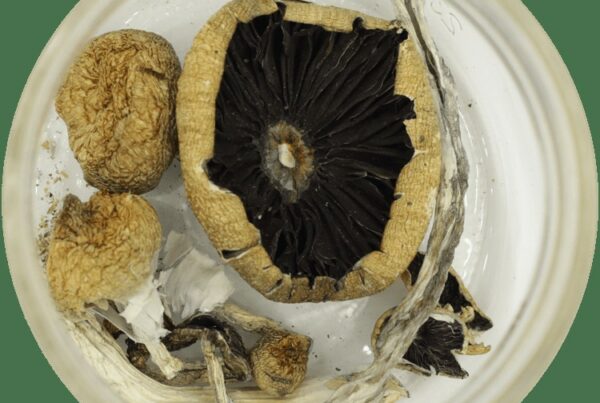Psilocybin mushrooms, similar in their serotonin 5-HT2A receptor agonist action to LSD, are a conventional type of psychedelic. Presently, these mushrooms are under investigation in psilocybin-supported therapy for mental health issues, such as emotional distress linked to major depression, anxiety, cluster headaches, and migraines.
To understand how shrooms assist in alleviating these conditions, it’s important to examine their metabolic processes within the body. This knowledge enables both researchers and consumers to understand how the active ingredient triggers psychological and therapeutic results. This article offers a basic overview of the pharmacology and pharmacokinetics of psilocybin.
[toc]
Key Takeaways:
- Half of the psychedelic fungi ingested is absorbed and distributed throughout the body.
- The compound in the fungi undergoes dephosphorylation through the enzyme alkaline phosphatase, mainly in the liver.
- Approximately 3.4% of the compound is excreted in its unaltered form within 24 hours, with the majority eliminated as a stable metabolite.
What is Pharmacokinetics?
Pharmacokinetics (PK) is the study of the body’s handling of substances like drugs after they are introduced into the system. Though separate, it’s related to pharmacodynamics, which studies how a substance interacts with the body. PK focuses on four main areas: absorption, distribution, metabolism, and excretion (ADME).
Comprehending these processes helps medical professionals prescribe the most effective medications with the least risk. It also allows them to customize treatments according to each patient’s unique physiology and lifestyle.
How does Pharmacokinetics relate to Psilocybin?
Psilocybin and psilocin, the primary active compounds in certain magic mushroom species, have piqued significant interest among researchers and users. Pharmacokinetics studies how these mushrooms, containing psilocybin, are processed by the body, aiding in understanding their potential medicinal or recreational effects.
These compounds are known by multiple names, including “magic,” “psychedelic,” “medicinal,” or “sacred.” The fungi containing these compounds are consumed, with The Varieties of mushrooms, their place of origin, size, the conditions in which they grow and are processed, and their age can lead to considerable differences in their potency levels.
Even though these mushrooms can be found in the wild, scientists have devised techniques to create them in laboratory settings. Both the natural and lab-grown versions have low toxicity, although minor side effects like nausea or vomiting may be experienced.
Despite the possible physical side effects, the compounds inside these mushrooms exhibit potential therapeutic benefits due to their safety and non-addictive properties. This has encouraged researchers to investigate their application in psychotherapy, particularly for treating anxiety and depression.
The 4 Phases of Pharmacokinetics
Psilocybin, the compound found in these mushrooms, is in an inactive state initially and performs as a prodrug, transforming into its active form, psilocin. Enzymes such as alkaline phosphatase facilitate this conversion, enabling psilocin to be absorbed and circulated across the body, reaching various tissues. However, post oral administration, psilocybin is undetectable in the circulatory system, feces, or urine.
Absorption
Absorption is the process by which the compound enters the bloodstream from the point of administration. It determines the speed and effectiveness with which the compound reaches its target, such as the plasma. The oral route is most commonly used for administration. While inhalation has been tried, it is not as effective as oral ingestion.
The absorption phase also involves the compound’s release from the dosage form during oral intake. Factors such as a delay in the throat or esophagus can affect this, possibly slowing down the results or causing discomfort. Once the compound reaches the stomach, the acidic environment might start breaking it down before it enters the bloodstream.
Studies on animals suggest that only around 50% of orally administered psychedelics get absorbed and spread throughout the body.
Factors Impacting the Absorption Procedure
A number of factors can influence the absorption, leading to variations in the onset, intensity, and duration:
- Stomach Contents: A full stomach can delay the process as it slows the onset of effects. Conversely, an empty stomach allows for quicker absorption.
- Body Fat: Substances can accumulate in fat tissues, which might prolong their effects.
- Age: Body composition and metabolic rates can vary with age.
- Zero-Order Kinetics: The substance is removed at a steady rate, regardless of its concentration.
- First-Order Kinetics: The elimination rate is in direct proportion to the drug’s concentration.
The term distribution refers to how psilocin is dispersed through the body after entering the bloodstream. Psilocin’s lipophilic nature allows it to traverse the blood-brain barrier and access the central nervous system.
system.This process is influenced by several factors, including the product’s size, polarity, and protein-binding capacity, and individual physiological characteristics such as hydration status and body composition.
The goal is to achieve an effective concentration at the targeted location. The product must reach the specified area, as dictated by the volume of distribution, and remain unbound to proteins in order to actively interact with its receptor.
What Factors Affect Distribution?
Several factors can influence the distribution process:
Usually, effects start to manifest 20-40 minutes after ingestion, peaking around 80-100 minutes, and the impact of magic mushrooms typically lasts between 4-6 hours.
How is Brain Distribution Achieved?
Initial studies on two species showed that the binding affinity sequence is 5HT2A > 5HT1A > 5HT2B [23]. It also attaches to dopamine D1, 5HT1E, 5HT5A, 5HT7, 5HT6, D3, 5HT2C, and 5HT1B receptors.
It acts as a partial agonist at the 5HT2A receptor, with an efficacy of about 40%. The psychedelic effects can be linked to its partial agonist activity at 5HT1A autoreceptors.
The mood-enhancing and psychotomimetic experiences may stem from the observed link between increased dopamine levels and sensations of depersonalization and euphoria. Hallucinogens work by altering neurochemistry and receptor activity. They enhance 5HT2A agonist activity by boosting BDNF synthesis in the hippocampus, which promotes neurogenesis and reduces conditioned fear-related behaviors.
Elimination
Elimination refers to the process by which the
The body removes a substance predominantly through the kidneys, but also via the lungs, skin, or gastrointestinal tract. With respect to the kidneys, the substance, which is a naturally occurring psychedelic drug, is filtered in the glomerulus or secreted in the tubules. However, the process is complicated by some reabsorption.
The primary compound has a half-life of about 160 minutes, whereas psilocin has a half-life of roughly 50 minutes. Animal studies have demonstrated that it is mainly expelled in the urine, which accounts for approximately 65% within 8 hours of intake. Even after consumption, smaller quantities of the substance can still be detected in the bile and feces.
In human bodies, about 3.4% of the substance is discharged in its original form within a day, while the majority is removed as psilocin-O-glucuronide, a more stable metabolite. The stability of this metabolite allows the substance to be detectable in urine samples for a longer duration.
The following are the two main methods of substance elimination:
Most psychedelic drugs abide by the first-order kinetics method, achieving equilibrium concentrations after four to five half-lives. Full elimination also occurs after this duration.
Discover Our Range of Hallucinogenic Mushrooms
The metabolic process varies across different types of fungi. Purchasing from reliable online vendors like Shroom Store Canada helps avoid the accidental consumption of poisonous mushrooms. Some varieties, like Agaric mushrooms, may produce intense and undesirable effects. Thus, it’s vital to procure magic mushrooms from dependable sources, avoiding potentially hazardous street vendors or wild foraging.
| Feature | Enigma | Full Moon Party | Gold Member | |
| Strain Type | Psilocybe Cubensis OMNI | Psilocybe cubensis (Thai Koh Samui) | Psilocybe cubensis | |
| Potency | Exceptionally high; 3.8% tryptamine content | Moderate to high potency | High potency | |
| Visual Characteristics | Resembles a blob or | Resembles a cauliflower or brain | Displays typical cubensis traits; medium in size | Thick white stems with golden caramel caps; visible blue bruising |
| Effects | Considered the most potent; induces intense effects | Produces a strong mental high; onset is delayed but comes with vivid visuals | Delivers powerful visuals and euphoria |
Educate Yourself on Psilocybin Mushroom Use Online
For medical professionals, researchers, and users alike, it’s crucial to understand the pharmacokinetics of shrooms. This knowledge empowers you to make informed decisions about dosage and timing, thereby reducing potential risks.
Discover your perfect psychedelic experience at Shroom Store Canada. Whether you’re after a soothing journey or a deeper exploration, our diverse array of products is designed to meet your unique requirements. Enjoy top-grade, safe, and quality-assured shrooms, and put aside worries about unreliable sources or poisonous mushrooms.
Indulge in the best magic mushrooms Canada provides and enhance your psychedelic adventure to unmatched heights.
Frequently Asked Questions
Is there any known interaction between shrooms and other drugs?
Yes, our products can potentially interact with certain drugs, particularly those that affect serotonin levels, like SSRIs (Selective Serotonin Reuptake Inhibitors). SSRIs and SNRIs (Serotonin and Norepinephrine Reuptake Inhibitors) usually lessen the effects, unlike non-serotonergic antidepressants. This reduced effect can last for up to three months after stopping the use of the antidepressant.
Do all psychedelic substances follow the same metabolic pathway as psilocybin?
No, each psychedelic substance has a unique structure that requires different metabolic processes to become active, and they attach to various receptors in the body. The administration method also affects how each psychedelic is absorbed. Although the basic principles of absorption, metabolism, and distribution are the same, the specific pathways and effects vary for each substance.
Does the form of the mushroom affect the pharmacokinetics?
Indeed, the form (be it fresh, powdered, or dried mushrooms) can influence the absorption rate. For instance, powdered forms might be absorbed faster than whole dried ones due to quicker dissolution.
Suggested Reads:





